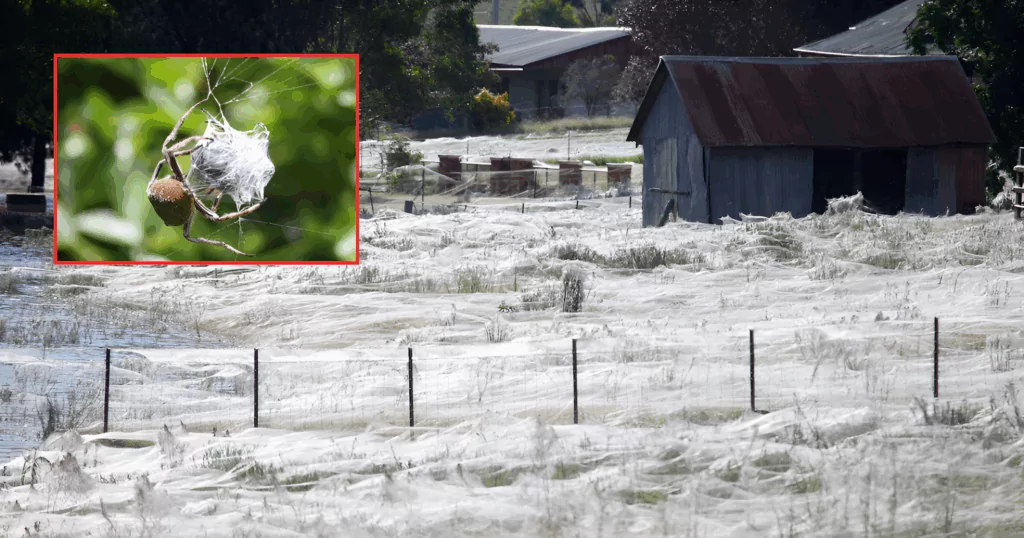Australia’s Flying Spiders – The Breathtaking Migration That Turns Landscapes Into Silk-Laced Marvels
Every year, as the final days of summer give way to the crispness of early autumn, regions of Australia experience one of the natural world’s most surreal spectacles. Entire fields, fences, trees, and rooftops become veiled in fine, white silk—not from frost, nor snow, but from a remarkable event known as spider ballooning.
This phenomenon occurs when countless small spiders—primarily juveniles—climb to elevated points such as tall grass, fence posts, or shrubs and release long, thin strands of silk. Caught by the wind, these gossamer threads lift the spiders into the air, allowing them to travel vast distances. It’s a form of airborne dispersal, and when weather conditions align just right—especially after rains followed by clear skies and light winds—millions of spiders take flight simultaneously.

The result? A stunning, shimmering tapestry of spider silk that can stretch for miles, draping the Australian countryside in ghostly white. It’s an eerie but utterly mesmerizing sight—one that often leaves both residents and visitors stunned, cameras in hand.
While the visual impact of mass ballooning can feel unsettling to some, it’s entirely natural and completely harmless. These aren’t aggressive spiders descending from the sky, but rather tiny arachnids using their innate navigational instincts to find new habitats. In many ways, it’s comparable to bird migration—except instead of wings, these spiders rely on their silk and the wind.

The spectacle may resemble a science fiction scene—something out of a post-apocalyptic film where the Earth is covered in fine white filaments—but it reflects an evolutionary marvel. Spider ballooning has been documented for centuries and isn’t exclusive to Australia. However, due to Australia’s unique landscape, large-scale weather patterns, and abundance of ballooning species, the country experiences this migration on a breathtaking scale.
Biologists say ballooning serves a crucial purpose: it allows spiderlings to escape overcrowding and locate areas with more abundant food sources. This natural dispersal helps maintain ecological balance and even contributes to controlling pests in new regions.
Interestingly, scientists have observed that ballooning spiders are sensitive to both thermal air currents and electrostatic forces in the atmosphere, allowing them to lift off and navigate effectively, even in conditions where the wind is minimal. This has drawn the attention of physicists and engineers, fascinated by the possibility of nature-inspired flight mechanisms.
Despite the sheer volume of spiders involved, mass ballooning rarely poses any threat to humans or animals. Most of the ballooning species are tiny, non-aggressive, and pose no danger beyond the visual surprise of finding webs blanketing your backyard overnight. In fact, many Australians have come to see this event not as a nuisance, but as an annual reminder of nature’s weird and wonderful rhythms.
Still, the scene often sparks headlines around the world. Photos of entire farmlands wrapped in silky threads tend to go viral, drawing comparisons to haunted landscapes or alien invasions. But for scientists, farmers, and wildlife enthusiasts, it’s a moment of awe—a fleeting but powerful testament to nature’s creativity.
To date, mass ballooning remains one of Australia’s most visually compelling—and biologically significant—natural events. It may look otherworldly, but it underscores the ingenuity of evolution, the invisible forces of atmospheric science, and the intricate connections between even the smallest creatures and their environments.
So the next time early autumn rolls around and the winds pick up across southeastern Australia, don’t be surprised if a morning walk reveals more than dewdrops glistening on the grass. You might just be witnessing one of nature’s most delicate journeys, floating silently through the air.
Main Source:
Live Science – Millions of spiders turn Australian landscapes into ghostly silk sheets in bizarre migration